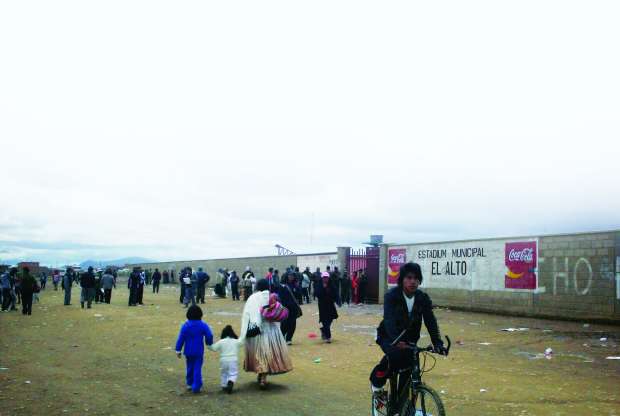 John Lyons says that one of South American football’s lesser lights is still well worth a visit..
John Lyons says that one of South American football’s lesser lights is still well worth a visit..
If you are a football fan keen to travel around South America, then Bolivia might not strike you as a key location to visit.
But you’d be foolish to ignore it. Okay, you’re not going to see the best players on the continent or the best teams (though Bolivar did cause a shock by reaching the semi-finals of last year’s Copa Libertadores).
However, what you experience in terms of quirky or downright bizarre incidents could more than make up for that.
Of course, if you think of Bolivia and its capital La Paz, one of the first things that springs to mind is altitude.
Just ask Diego Maradona whose Argentinian side were on the end of a 6-1 humbling in a World Cup qualifier in 2009. The Argies had the likes of Lionel Messi, Carlos Tevez, Javier Mascherano, Gabriel Heinze, Maxi Rodriguez and Martin Demichelis in their starting line-up. It was hardly a team of mugs. Unfortunately, I didn’t get the chance to see that game – though I did walk on the pitch at the rather dilapidated Estadio Hernando Siles a couple of years later.
I took a stroll up to the stadium, some 3,600 metres above sea level, one afternoon – and just walked in. The gates were open because there was some athletics training going on, so, as no one was remotely bothered, I walked on the pitch and took a few pictures as a souvenir.
It’s not often you get to see the President of a country playing football either, but I was able to witness Bolivia’s Evo Morales playing in a charity game at the same venue another day.
In a match to help those who had lost their homes due to flooding, Morales lined up alongside players from Bolivia’s World Cup squad of 1994 against current day players.
The portly President’s popularity was waning at that time, so there were plenty of boos from the packed out crowd every time he touched the ball, which wasn’t often.
Returning to altitude, I’ll never forget going to see the Potosi derby – Nacional Potosi versus Real Potosi – though I didn’t end up watching much of the match.
I asked a couple of Belgian tourists if they wanted to go to the game with me and they said yes. Things started to go wrong when we got stuck in massive queues outside the ground on a boiling hot day – this was a game everyone in Potosi wanted to watch.
We eventually managed to get in, but the Belgian girl started to feel a bit rough. She went to lie down in the little shade she could find behind the hoardings and then began to have trouble breathing, which only made her panic more.
We rushed to get her some medical help and she was given an injection. She was then lifted onto a stretcher, carried out of the stadium with me and her boyfriend in tow and put in an ambulance. (I must admit I was tempted to let them go on their own, but, ultimately, thought I’d better stay with them).
As we roared away in the ambulance, I suddenly heard the roar of the crowd – there had been a goal in the opening few minutes.
With some medical help, the Belgian was feeling better by around half-time and was given a lift home along with her boyfriend. I went back to the stadium in the hope of salvaging something from the afternoon, but the gates were all locked and the security staff weren’t buying my story that I’d already been inside and that was why I only had half a ticket. Perhaps my shocking Spanish didn’t help.
Eventually, the gates opened with 20 minutes left to let people out – and I was able to sneak in.
Another time, I ventured to El Alto, near La Paz, to witness a game and it was there that I got a first-hand listen to the typical South American broadcaster’s seemingly never-ending shriek of ‘goooooooooooooooooooal!’
I was sitting near the commentator and when the goal went in, he paused for about 30 seconds and it was only then that he launched into his celebration. Perhaps he needed the time to fill his lungs.
El Alto was in the news a few years back when fans of La Paz FC, furious with the news that their team could have their matches transferred to the Hernando Siles, thought of an original way of protesting – they kidnapped the whole squad.
Okay, kidnap maybe sounds a bit strong, but they did lock the 43 players and coaches inside the Estadio Los Andes for more than four hours after a training session.
Another quirky thing about Bolivian football is the team names. My favourite team is The Strongest, from La Paz, while Blooming, from Santa Cruz, is another name that I like.
To sum up, it would be a Blooming shame if you missed out on Bolivian football. You simply never know what’s going to happen next.


















